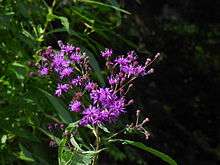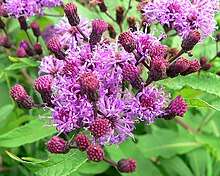Vernonia gigantea
Vernonia gigantea (also known as giant ironweed,[1] tall ironweed[2] or ironweed[3]) is a species of perennial plant from family Asteraceae found in United States and Canada.[1] The plant is native to the eastern United States, north to New York state and Ontario, and southwest to Texas.[1]
| Vernonia gigantea | |
|---|---|
 | |
| Tall ironweed near Cincinnati, Ohio | |
| Scientific classification | |
| Kingdom: | Plantae |
| Clade: | Tracheophytes |
| Clade: | Angiosperms |
| Clade: | Eudicots |
| Clade: | Asterids |
| Order: | Asterales |
| Family: | Asteraceae |
| Genus: | Vernonia |
| Species: | V. gigantea |
| Binomial name | |
| Vernonia gigantea (Walter) Trel. | |
Description

(Vernonia gigantea)
They are described as 3–7 feet tall,[4] or 5-10 by 1–2 feet.[3] The stem is either green or purplish green coloured, and can be either hairy or pubescent. The leaves are up to 10 inches long and 2½ inches across, and are ovate. Their leaves could also be lanceolate-oblong or elliptically shaped, with serrated margins. The leaves' upper surface is hairless and is dark green in colour. The leaves' base has either a petiole or sessile.[4] The flowers bloom from July to September and are purple coloured. They can be found growing in moist soils by the roadsides, and are common in the meadows and open woodlands.[3]
The seeds are wind-dispersed. The plant is self-incompatible and exhibits substantial ecotypic variation, a factor which may explain their broad geographic distribution.[5]
Ecology
It is a larval host to the ironweed borer moth (Papaipema cerussata) and the red groundling moth (Perigea xanthioides).[6]
References
- "Vernonia gigantea". USDA. PLANTS Profile. Retrieved September 7, 2012.
- Common names
- "Vernonia gigantea - Ironweed". Goodness Grows. Retrieved September 7, 2012.
- "Tall Ironweed". Illinois Wild Flowers. Retrieved September 7, 2012.
- Urbatsch, Lowell (1973). "A Study Of Ecotypes In Vernonia Gigantea Gigantea (Compositae)". Transactions of the Nebraska Academy of Sciences and Affiliated Societies. p. 188. Retrieved 10 October 2015.
- The Xerces Society (2016). Gardening for Butterflies: How You Can Attract and Protect Beautiful, Beneficial Insects. Timber Press.